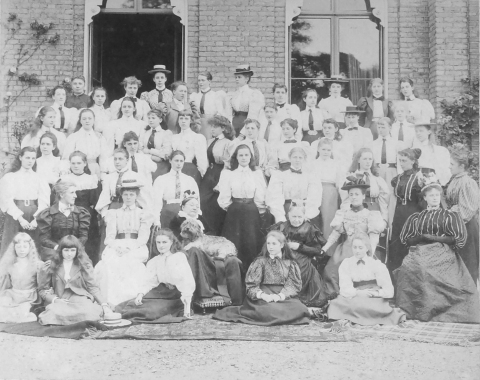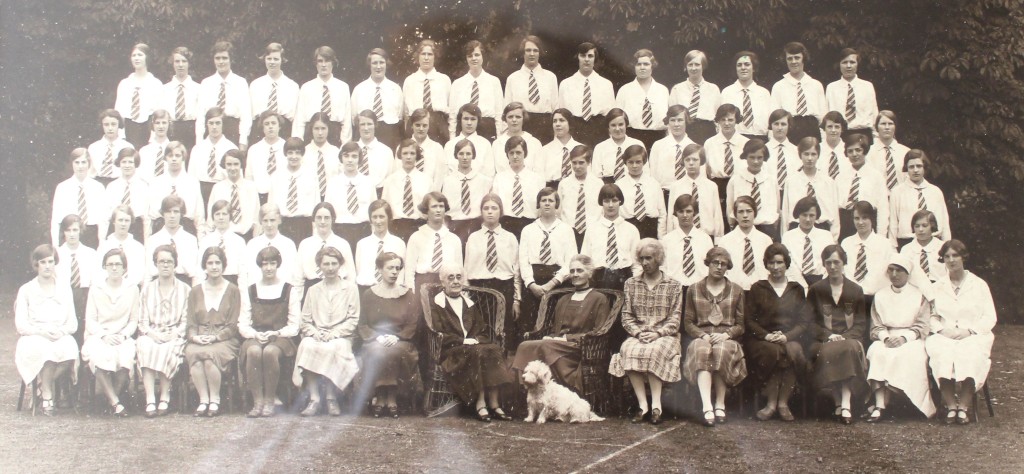West Heath – a short history
The beginnings of West Heath came with a vicar, Revd PB Power MA, and his formidable wife.

Having a dog join staff and pupils became a regular feature of school photos over the years.
The couple had four daughters and the family lived in a beautiful William and Mary house close to the Thames in London. It was called Abbey Wood and in 1865 they decided to educate their offspring themselves, conducted on the religious principles dear to them. In addition, a wide range of subjects, with the exception of science, made up the syllabus.
Such was the reputation of the teaching that it was not long before a number of well-to-do families sought the academic values of Abbey Wood, enabling the Reverend’s daughters to continue their education in the company of other like-minded children.
When their own daughters finished their education, that the Powers decided in 1877 to continue the school but in a larger house at 1 Ham Common, in an area known as West Heath. The property was formerly owned by the Duc of Chartres, a Huguenot from France and it was from here that the House names of Chartres, Guise and Orleans originated.
The school’s reputation continued to grow under the principalship of Mrs Power. In 1890 it caught the attention of Miss Buckland and Miss Percival who owned a similar school in Reading. They joined forces with Mrs Power at Ham Common and 10 years later Miss Skeat and Miss Lawrence bought the school.
The following year they began a School Magazine and in 1904, the school participated in its first public examination organised by the Royal Drawing Society. Pupils achieved 18 honours and 25 pass certificates and this secured the beginning of the school’s scholastic reputation.
Miss Skeat and Miss Lawrence were dynamic and expanded the curriculum to include Economics, Woodcarving, Domestic Economy, Natural Science and the Theory of Music. Sport also took a leap forward with Hockey, Swedish Drill, Riding, Fencing, Swimming, Croquet, Tennis and Lacrosse.

The world was changing, with the Suffragettes, the First World War and the introduction of such wonders as electricity, the wireless, the telephone and the motor car. Education for women was being recognised and acknowledged more and more.
The girls now leaving the school not only went to Paris and Dresden to be ‘finished’ before returning to look after their homes, families and charitable institutions, but they also began to go to College and University.
In 1928, Miss Elliott joined the staff and was appointed Principal the following year. She recognised that the school, with 70 girls, had outgrown its premises and bought the Ash Grove house and estate in the Sevenoaks Common area. Immediately after the Second World War the numbers leapt to more than 100.

Miss Elliott was, like Mrs Power, a formidable person and led the new West Heath with direction and compassion. Her brilliance at teaching History and Literature was legendary as was her generosity, her teasing and passionate desire that everyone should share her love of music and painting.
Her staff was encouraged to be friendly, communicative and inspirational and that philosophy became the school’s mantra. Miss Elliott’s enduring legacy was to keep the school going and viable through the most difficult of years, while maintaining and enhancing the special qualities of West Heath.
By 1965, times had become more stable and Ruth Rudge became Principal in the midst of ‘Beatlemania’ and at a time when teenagers were finding their voice with music was taking off in many different directions.
A television in every home was becoming the norm and although the choice of channels was considerably more restricted than the present day, TV advertising began to help develop a culture for more possessions, and a generation gap syndrome became more evident.
Ruth Rudge incorporated all the changes into the running of the school while continuing to develop an ethos in which West Heath girls – and the staff – could be lively, outgoing, tolerant, and generous.
Traditions introduced over the years such as Fancy Dress, hosted by Elm, and Carols by Candlelight, also continued to be popular.

In 1988, Ruth Rudge handed the baton to the new Principal, Mrs Cohn-Sherbok who carried on the school’s tradition, its language, its ethos with warmth and dedication.
Mrs Cohn-Sherbok was followed by Rosemary Ditchburn in the mid-90s and then Ann Williamson who was at the helm in 1997 when the governors announced the school’s financial situation was forcing it to close . The details were announced to parents at the end of the summer term. Despite a desire by parents to investigate ways for the school to continue, the doors were officially closed on 31 August 1997 and West Heath went into receivership the following day.
Businessman Mohammad Al Fayed, who at the time owned Harrods and Fulham Football Club, announced he was buying the West Heath estate and agreed to lease it to a charity run by Principal Val May who had gained a reputation for teaching children whose education, for a variety of reasons, had broken down.
The New School at West Heath opened in 1998 and in 2015 changed its name to West Heath School. Although it has no direct connection to the old school, it ensures the West Heath name lives on…
The new school warmly welcomes visits from old girls and former staff from the original West Heath who can take a nostalgic walk down Memory Lane.
For more information on the history of Ash Grove house and its gardens before it was occupied by West Heath use this link below to go to:
The Kent Compendium of Historic Parks and Gardens
for Sevenoaks District

The grass tennis courts are just visible in the gardens behind the main building.
Leave a comment